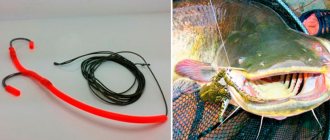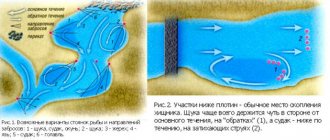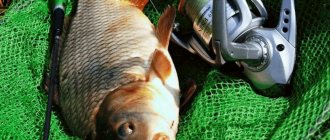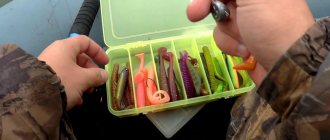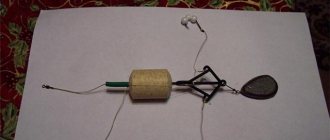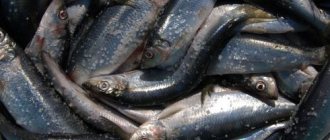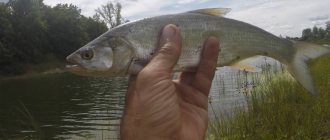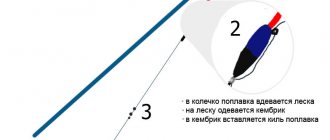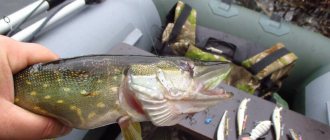How the half-bottom is equipped
A distinctive feature of this gear is that during fishing the main equipment is located at the very bottom. Namely, many species of fish live here and they rush here in search of food.
The lower part of a half-bottom fishing rod is equipped like a regular bottom fishing rod - with a sinker and a hook on a fishing line, which are constantly located at the very bottom. All that remains of the float tackle is the float, which is installed above the surface of the water. Therefore, such tackle received a clear definition - half-bottom.
We also recommend reading:
Budget spinning reels Riobi Exiya Features of crucian carp killer gear and how to make such equipment Diagram of how to learn how to tie a hook to a fishing line Features of fishing with a retractable leash, selection of gear and installation
Briefly about the advantages of universal gear
A half-bottom with a float is a symbiosis of two types of fishing rods. The lower part is equipped with a heavy sinker that allows you to hold the hook in one place. The float is a bite alarm; it is placed near the whip.
Some fishermen can do without it, but this is not for everyone. The tackle ends with a fishing rod, mainly from a float rod.
Spring and early summer are a period of productive fishing with half-bottoms. You can fish with gear in the fall, but cautious fish are afraid of thick line, although fearless crucian carp can attack your bait without paying attention to the “roughness” of the equipment. The half-bottom has a number of advantages:
- the tackle remains in place even in strong currents. To do this, just add the weight of the sinker and pick up the line;
- The method is effective when fishing in muddy water where meltwater flows from the fields. Schools of peaceful fish always graze here, gaining weight after winter and preparing for spawning;
- the gear allows you to fish areas of the coast overgrown with bushes, trees and other places where fishing with wire is impossible;
- the probability of snagging on debris or other obstacles is reduced to 0. The sinker is lowered to the intended place, and does not drag along the bottom, clinging to snags, plants or stones;
- allows you to fish from the shore and from a boat;
- The scaffolding is always taut and stands almost vertically. This quality makes the equipment sensitive to careful bites;
- universal type of equipment. You can successfully catch roach or ram, and by installing a jig, you can catch perch or other predators.
[custom_ads_shortcode1]
Sinkers for half-bottoms
An important part of the half-bottom equipment is the sinker, the weight of which depends on:
- casting distance,
- current forces,
- fishing line sections.
The best option for fishing with a half-bottom is when the load is completely on the bottom. When choosing gear from the water, sinkers can get caught, so their different shapes allow you to distribute the weight in such a way as to avoid this unwanted moment.
It is possible to use several weights (3-4 pieces), which are located close to each other (2-3 cm). If the current begins to intensify, then only a couple of sinkers will come off the bottom; as soon as the current decreases a little, they will return to the bottom again.
Such equipment is in constant readiness and any, even the most careful bite, will be noticed. If the equipment is not loaded enough, it will be washed ashore or lifted to the upper layers. For additional weight, you can use lead plates. Sometimes the sinker is installed at the end of the line, and the leash follows higher. The best option is to place a small sliding sinker on the working line up to the leash.
Fishing rules
Fishing is best started after preliminary feeding. Since the fish must be lured almost to the shore, the bait is poured out “under your feet.” Gradually, the current will wash it away to the fishing point, and the fish will rush to the stern. You should fish like a fly rod. The line should be slightly longer than the rod. Gradually it will be possible to lengthen the fishing distance if there are no bites. This is how you “grope” for a cluster of peaceful fish. The fishing rod must be positioned at an angle of 60-70 degrees to the current, parallel to the water's edge. To do this, you will need stands for the fishing rod; some “aces” of the half-bottom hold the tackle in their hands. The optimal rod length will be when the fishing line on the installed fishing rod is parallel to the coastline. Now the slightest touch of the fish will not go unnoticed by the fisherman.
Mastery of a fisherman comes with experience, which accumulates from fishing to fishing. Accurate determination of where the fish is located, correct supply of bait and bait, determination of the moment of hooking - these are the main points of successful fishing with any tackle, including half-bottom.
Fishing
Rules for successful fishing
Which rod is better for half-bottom fishing?
For a half-bottom, you can use a regular telescopic rod 5-6 m long, equipped with guide rings, as well as a reel with a reserve of fishing line, allowing you to adjust its length for long casts.
For casting, the prepared supply of fishing line is placed on the ground, and in such a way that when casting it moves freely behind the load, and part of the fishing line with the equipment is held in the hand. With the other hand, the rod is lifted from the stand, the rig is swung and sent with a smooth movement forward. But when fishing for fish, the rod is not used, and you have to fish out the prey using the fishing line. Therefore, a regular rod 5-6 meters long is quite suitable for a half-bottom.
Half-bottom equipment
A large selection of modern fishing rods opens up wide possibilities for anglers in equipping a half-bottom. For small rivers, feeder or Bolognese rods up to 4 m long with a sensitive tip are suitable. The shallower the depth and weaker the current, the thinner the tip should be. The range of weights used is from 4 to 8 g. For medium and large rivers, the rod requires a longer length of 5-7 m, and the weight of the sinkers reaches 10-15 g.
The half-bottom is equipped with a spinning reel with a friction brake of size 2500-4000, depending on the length of the main line and the type of intended prey. For ordinary river fish, 50 m of fishing line 0.25-0.28 mm is enough, but if there is carp in the river, then both the diameter of the main fishing line and its length should be increased.
Installation of the gear is quite simple. The main line needs to be passed through the guides of the rod and threaded through a sliding sinker in the shape of an olive. Next, you should attach a rubber stopper-shock absorber to the fishing line and tie a regular double loop. The leashes are made from pieces of fishing line 0.18-0.2 mm long, 50-70 cm long. The hook must be sharp, its size is limited by the size of the bait, as well as the size of the intended fish. A loop is made at the other end of the leash, with which it will be attached to the main fishing line. All that remains is to adjust the operation of the friction brake and start fishing.
Float selection
The float for the half-bottom should be selected in such a way that its weight gives the fishing line a certain bending angle, then any touch of the fish to the nozzle will tighten the fishing line and set the float in motion. Therefore, the floats used are quite heavy, which have a traditional elongated shape, with one or two attachment points. Instead of a float, you can use bells and various signaling devices; after attaching them, it is again necessary to form an obtuse angle with the fishing line.
Half-bottom fishing strategy
We found out what kind of gear this is, and also decided on the fishing spots. Now it’s time to learn the fishing strategy. Anglers who prefer to fish with a half-bottom usually choose two main strategies:
- "Don't sit still." The fisherman does not stop in one place, but constantly moves along the coastal zone of the river and stops in places of possible biting. Naturally, in this case there is no need to use any bait; at most, you can throw a handful of grains directly at the fishing point, immediately before fishing.
There is no reason for an angler to linger in one place for a long time; his task is to catch active fish that are in the fishing spot at a specific time. His entire catch will consist of active fish, so the greater the distance the angler travels, the richer his catch will be.
- "Watching fishing" In this case, feeding with large fractional food occurs and subsequent stationary fishing awaits the “reward”. You can’t expect frequent bites here, but if they happen, you’ll come across large specimens. To quickly attract fish, they are fed with corn grains or steamed pearl barley, throwing them at the fishing spot every half hour.
Features of fishing with a half-bottom
Half-bottom fishing can be done throughout the open water season, but the most effective fishing occurs in spring and early summer. Since this tackle is quite coarse, in clear summer water it is less likely to catch well-fed fish. In the spring after spawning, exhausted fish are not picky and less cautious, so fishing with a half-bottom is more successful and effective.
It is better to use maggots and worms as bait during this period. When the gear is ready, they are cast across the river; after some time, the current will set the line in a straight line from the nozzle to the float. The guard should be located at a distance of 10-20 cm from the surface of the water. If no bite is observed, you should move to the side and make a “recast”.
When a fishing spot is discovered, you can position yourself thoroughly, cast to the fishing point and patiently wait for a bite. You should not hook immediately, but wait a little, since the bait for the half-bottom is usually used large, and the fish needs time to swallow it. We recommend reading the article on how to make a donk from a spinning rod.
How to choose the right fishing spot?
Determining a suitable fishing spot is important in any type of fishing, but for half-bottom it is critical, given the rather narrow scope of its application and the short fishing distance. The best places for half-bottom are the coastal shallows of small rivers with a folded bottom and the absence of algae, snags and large stones. Large fish come to the shore along the bottom grooves to feed, especially in the morning and evening hours. The second promising place is whirlpools near steep banks with a reverse current and a depth of 2-3 m.
Read more
How to catch pike in spring on small rivers?
When choosing a fishing spot, you must also pay attention to the fact that there are no obstacles nearby for manipulating a long rod - bushes, trees, reeds. Considering that large fish, which the half-bottom is primarily aimed at, are usually careful, it is better to prepare the fishing spot in advance - this will help to avoid unnecessary noise during the fishing process.
